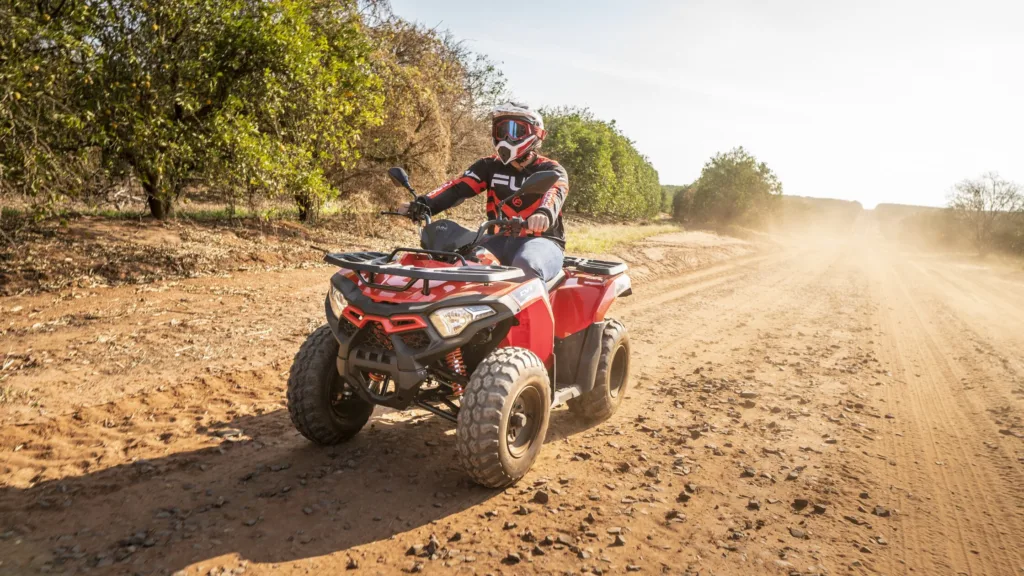Always wear a helmet and protective gear when riding an Atv Safety Rules, and take a hands-on safety training course. Never carry a passenger on a single-rider ATV, and avoid paved roads.
Exploring the great outdoors on an all-terrain vehicle (ATV) can be thrilling. However, to ensure a safe and enjoyable experience, riders must follow key safety rules. These guidelines are crucial to prevent accidents and injuries. Equipping yourself with the right safety gear, particularly a helmet, is non-negotiable.
Engaging in a hands-on safety training course equips riders with necessary skills and knowledge. Riding on designated trails at a safe speed, keeping off paved roads meant for other vehicles, and respecting the ATV’s limits regarding carrying passengers are fundamental safety practices. By adhering to these safety measures, riders can enjoy the adventure that ATVs offer while minimizing risks.

The Need For ATV Safety Rules
The thrill of riding an ATV brings adventure seekers to the great outdoors. But with the roaring engines comes a significant responsibility for safety. Understanding the need for ATV safety is crucial to protect riders from potential harm. Riding smart keeps the fun alive.
Rising Popularity And Associated Risks
ATVs are gaining fans across age groups and terrains. This surge in use inevitably brings more risks. Unpredictable terrain and high speeds pose challenges even for experienced riders.
- Increased ATV Sales: More ATVs in circulation means more risk on trails.
- Varied Ridership: Users of all skill levels are taking to the trails.
With popularity, the urgency for strict safety measures heightens. Educating riders on the potential dangers is a step towards preventing accidents.
Common Atv Injuries
ATV accidents can result in serious injuries. Prevention is better than cure. Awareness of common injuries can alert riders to the importance of safety gear and proper riding techniques.
| Type of Injury | Prevention Tips |
|---|---|
| Head Trauma | Always wear a helmet. |
| Broken Bones | Use protective gear, like pads and boots. |
| Cuts and Bruises | Stay cautious of surroundings. |
Remember, knowledge of these injuries encourages safer riding behaviors. Every rider must prioritize their welfare and that of others around them.

Essential Atv Gear
Heading out on an all-terrain vehicle (ATV) is a thrilling experience. Wearing the right gear makes it safe too. Gear up for adventure while ensuring your safety. Let’s dive into the essentials you must have before revving up your ATV.
Helmet: Your Vital Protection
The helmet is the most crucial piece of safety equipment for ATV riders. A good helmet:
- Shields your head in case of falls or accidents.
- Must meet the Department of Transportation (DOT) standards.
- Should fit snugly while not obstructing your vision or hearing.
Choose a full-face helmet for maximum protection. It covers your entire face, protecting you from debris and wind. Remember, a helmet is a rider’s best defense. Never ride without it.
Appropriate Clothing: Beyond Comfort
ATV riding demands more than casual attire. The right clothing will protect against harsh elements and injuries. Here’s what you need:
- Gloves: They offer a better grip and shield hands from scrapes.
- Boots: Sturdy boots support ankles and prevent foot injuries.
- Long Pants and Sleeves: Durable materials like denim or leather guard skin against abrasions.
Avoid loose clothing that can get tangled in the ATV. Bright colors or reflective gear make you more visible to others. Safety always comes first.
Pre-ride Inspections
Jumping onto your ATV without a proper pre-ride inspection is like skydiving without checking your parachute. To ensure your ride is as safe as it is exciting, perform these essential checks before hitting the trail.
Checking Tires And Brakes
Well-maintained tires and brakes are crucial for safe ATV handling. Look for these before you ride:
- Air Pressure: Use a gauge. Ensure it matches manufacturer specifications.
- Tread: Check for wear. Replace tires if the tread is low.
- Brakes: They should feel firm. Listen for unusual sounds.
Fuel, Oil, And Coolant Levels
A smooth ride relies on adequate fluids. Don’t overlook:
| Fluid Type | Check Procedure | Optimal Level |
|---|---|---|
| Fuel | Inspect the tank. Refill if low. | Full |
| Oil | Use the dipstick. Wipe and re-dip for accuracy. | Between marks |
| Coolant | Check the reservoir. Top up if needed. | Adequate |
Always consult your ATV’s manual for specific instructions. Ride with confidence knowing you’ve set the stage for a safe, thrilling adventure.
Riding Techniques To Stay Safe
Exploring the wilderness on an ATV brings adventure but requires skill and caution. To ensure you have a thrilling yet safe ride, mastering specific riding techniques is vital. These techniques not only enhance the enjoyment of your journey but are crucial for your safety. We’ll guide you through essential practices, starting with the cornerstone of ATV control—body positioning.
Mastering Body Positioning
Effective body positioning is your first line of defense against unexpected movements on your ATV. A well-balanced stance allows for better control, especially when steering or adjusting speed. Find your center of gravity to maintain stability. Remember these key points:
- Sit squarely on your ATV, with your bottom firmly in the center of the seat.
- Keep knees and elbows slightly bent for flexibility.
- Lean forward while going uphill and back when going downhill.
- When turning, lean your body into the curve, not away from it.
Navigating Different Terrains
Each terrain type on an ATV adventure poses its unique challenges. Effectively navigating different terrains is critical to minimize the risks. Here’s what to keep in mind:
| Terrain Type | Techniques for Safe Riding |
|---|---|
| Mud | Maintain momentum and use a steady throttle. |
| Sand | Accelerate slightly to keep the front wheels light. |
| Rocks | Stand up on the foot pegs and allow knees to absorb shocks. |
| Hills | Increase your weight on uphill, decrease on downhill. |
Understanding Atv Laws And Regulations
Roaring engines and muddy tracks might sound exciting, but they come with responsibility. ATV riders must understand the laws and regulations to stay safe and legal. Knowing the rules helps prevent accidents and protect our beautiful outdoors.
Age Restrictions And Rider Education
Safety starts with knowing who can ride an ATV. States enforce different age restrictions to ensure riders are capable of handling these vehicles.
- Minimum ages can range from 10 to 16 years old.
- Rider education is often required for young or new ATV enthusiasts.
| State | Minimum Age | Education Required |
|---|---|---|
| New York | 10 | Yes |
| California | 16 | No |
Always check your state’s Department of Motor Vehicles for the latest guidelines.
Legal Riding Areas And Environmental Concerns
Not all terrains are open for ATV action. Riders must respect designated legal riding areas for their safety and nature’s well-being.
Nature preserves, private lands, and certain public areas are off-limits to prevent damage to ecosystems and wildlife. Look for signs and use maps to find approved trails.
- Check local park websites for trail maps.
- Respect closure signs to protect fragile environments.
- Avoid riding in wet conditions to prevent trail damage.
Remember, preserving our trails ensures we can enjoy ATV riding for years to come. Embrace the thrill of the ride while honoring the laws designed to keep everyone safe.

Reacting To Emergencies
Understanding how to respond effectively during ATV emergencies is crucial for every rider. Knowing the right actions can prevent injuries or even save lives. Let’s delve into essential safety measures and appropriate responses when facing sudden mishaps.
Handling Atv Tip-overs
Ride cautiously on uneven terrain to prevent tip-overs. The right reaction is vital if your ATV starts to tip. Don’t try to stop the ATV with your arm. In a tip-over, keep your body away from the machine.
- Switch off the engine immediately if safe to do so.
- Stay clear of the ATV to avoid getting trapped underneath.
- Seek help to upright the ATV if it’s too heavy to handle alone.
- Inspect the ATV for damage before riding again.
First Aid Basics For Common Injuries
Carrying a first aid kit is one of the basic ATV safety rules. Treatments should suit the injury type. Here’s a guide for common injuries:
| Injury Type | First Aid Response |
|---|---|
| Cuts and Scrapes | Clean with water, apply antiseptic, and bandage. |
| Sprains | Use R.I.C.E – Rest, Ice, Compression, and Elevation. |
| Broken Bones | Immobilize the area and seek immediate medical help. |
| Head Injuries | Call for emergency help, avoid moving the person. |
Frequently Asked Questions For Atv Safety Rules
What Are Essential Atv Safety Tips?
ATV riding demands cautious handling. Essential tips include wearing protective gear like helmets and goggles, receiving proper training, adhering to designated trails, and never overloading or riding tandem on a single-rider ATV. Always ride sober and respect the vehicle’s limits.
How To Properly Gear Up For Atv Riding?
Proper gearing up involves wearing a DOT-compliant helmet, gloves, long sleeves, pants, and over-the-ankle boots. Eye protection is crucial—either with goggles or a helmet visor. Gear should fit snugly to prevent snagging and provide adequate protection.
Can Children Operate Atvs Safely?
Children can operate ATVs with strict safety measures. They should use ATVs appropriate for their age and size, undergo hands-on training, and always be supervised by adults. Additionally, kids must wear all essential safety gear and ride on suitable terrain for their skill level.
What Is The Importance Of Atv Training Courses?
ATV training courses impart vital skills for safe handling. They teach proper riding techniques, decision-making on trails, and how to manage various terrains. Such knowledge greatly reduces the risk of accidents and enhances the rider’s confidence and safety awareness.
Conclusion
To wrap up, following ATV safety rules is crucial for an enjoyable ride. Remember to gear up, stay alert, and respect boundaries. By doing so, you help ensure thrilling adventures while minimizing risks. Enjoy the trails responsibly and keep the ride rolling safely.


